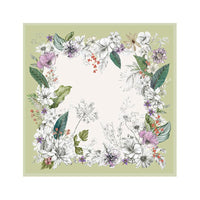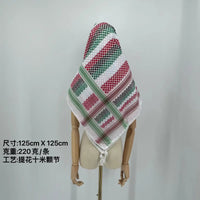Introduction: Square scarf - a time machine around the neck
In the ever-changing fashion, there are always some items that have the magic of traveling through time. Square scarf, a seemingly simple square fabric, is an outstanding representative of them. It is not only a practical accessory to decorate the neck, wrist or hair, but also a flowing mirror, accurately reflecting the changes in social thoughts, female roles and aesthetic concepts over the past century. From the bright stars of the Golden Age of Hollywood to the pragmatism of post-war reconstruction; from the exquisite and elegant lady style to the free and unrestrained rebellious spirit; from the calm restraint of minimalism to the carnival collision of retro and personality at present - every folding, tying method and pattern selection of the square scarf silently tells the story of an era. Let us follow the vein of time and unlock the unique fashion codes carried by square scarves in different eras.
Elegance and practicality intertwined: (1930s-1940s) Hollywood light and wartime wisdom
Catalyzed by Hollywood's glamour: In the 1930s, scarves ushered in their first golden age. This was largely due to the superstar effect of Hollywood's golden age. Screen goddesses such as Greta Garbo and Marlene Dietrich, with their unparalleled charm, interpreted the silk scarves tied around their necks, hair or hats as symbols of elegance and mystery. In 1937, Hermès launched its first silk scarf in Paris, setting the benchmark for luxury scarves with exquisite craftsmanship and unique narrative patterns (such as carriages and knights).
Pragmatism during World War II: Entering the 1940s, World War II had a profound impact on fashion. Shortages of materials, especially silk (mostly used in parachute production), made rayon the main fabric for scarves. The practicality of scarves was unprecedentedly magnified. Women were creative, wrapping their hair with scarves (the iconic image of "Rosie the Riveter"), replacing hard-to-buy hats, and even cleverly folding them as collars or decorating simple wartime clothing. In terms of patterns, flowers, geometric abstractions, patriotic symbols (such as flags and eagles) and slogans to boost morale became more popular. During this period, scarves were not only a reflection of women's tenacity during wartime, but also an important tool for maintaining respectability and femininity.

The peak of elegance and the prelude to rebellion: (1950s-1960s) Exquisite housewives and free souls
The ultimate femininity of the 1950s---After the post-war economic recovery, the 1950s ushered in an era of consumerism and emphasis on femininity. The way to wear a square scarf tends to be delicate, regular and highly feminine. The most classic is to tie a small square scarf into a small, tight bow or sailor knot in front of the neck, which is perfectly matched with Dior's "New Look" style waisted umbrella skirt, slim suit and shirt. Hollywood's dream machine After the release of "Roman Holiday" in 1953: - The sales of silk scarves in the United States increased by 47% month-on-month - "Hepburn knot" teaching appeared on the cover of "Life" magazine - According to statistics from the Italian Tourism Association, 23 silk scarf stalls increased around the Trevi Fountain, where the film was filmed.

1960s---The beginning of rebellion and diversity: The 1960s was a decade of dramatic social and cultural upheavals, and fashion also became diversified. A more important change was that scarves began to be embraced by the younger generation and subculture groups. Mods liked to wear narrow long silk scarves with strong geometric patterns, artistic pop styles or British flag patterns when wearing slim-fit suits. With the rise of the hippie movement, scarves became an important symbol of freedom, peace and spiritual pursuit. Tie-dye, paisley totems (especially influenced by Eastern mysticism), ethnic patterns, and psychedelic colors became mainstream, and the way of wearing them became more casual - tied on the head (headband or headscarf), wrapped around the forehead, draped over the shoulders, or used as belts or bag decorations, full of uninhibited bohemian style. The scarf began to transform from an elegant accessory to a declaration of cultural identity and attitude.

Freedom and individuality: (1970s-1980s) Disco craze and the rise of subcultures
1970s---Bohemian Continuation and Disco Sparkle: The 70s continued and amplified the hippie spirit. The scarves became larger in size and in a variety of materials (silk, cotton, chiffon). The turban-style wrap (wrap around the whole head or knotted at the forehead) remained popular, full of gypsy or country style. As disco music swept the world, the scarves also entered the nightclubs. Sequins, metallic luster, animal prints (leopard!) and bold geometric color blocks of scarves, paired with flared pants and shiny tops, sparkled under the spinning disco ball.

1980s---Power and subculture symbols: The 1980s was a decade of publicity, exaggeration, and the pursuit of power. In mainstream fashion, professional women wore power suits with broad shoulders, often paired with silk scarves with bright colors and eye-catching patterns (such as abstract paintings and large geometric patterns), tied in a full knot in front of the neck or casually draped, as a feminine embellishment in a strong look. Punk culture played with scarves (usually black, plaid, or cotton scarves with band logos) in new ways - tied on the wrist, tied on the legs, or as a substitute for fingerless gloves, full of destructive and street style.

Minimalism and street diversity: (1990s-2000s) Minimalism returns
1990s---"Quiet" existence under the minimalist trend: As a rebellion against the extravagance of the 80s, the 1990s advocated minimalism and "effortless cool" style. The overall presence of the square scarf was weakened, and the way of wearing it tended to be restrained and functional. It is common to tie a narrow long silk scarf (neckerchief) loosely around the neck, tie a simple flat knot or hang it casually, and match it with a simple white T-shirt, jeans or shirt like Calvin Klein.

2000s---fashion became more hybrid, eclectic and flamboyant. Hip Hop culture had a huge impact on fashion. The scarf (especially cotton scarf with eye-catching brand logos, sports team logos or specific street culture symbols) became a key street accessory. The way of wearing it is very distinctive - folding the scarf into a triangle, covering a large area of the head (Bandana style), or tying it on the forehead, hanging it on a backpack, or even tying it on the arm or trouser leg, showing identity and attitude. The scarf of this period is a mixed carrier of street fashion, luxury worship and personalized expression.

Retro resurgence and personality first: (2010s-2020s) nostalgia and infinite possibilities
The biggest feature of the 2010s is the repetition and reinterpretation of fashion elements from past eras. Thanks to the popularity of the vintage trend and the promotion of social media, almost all classic square scarf styles in history have found new fans.
Real products related to the epidemic
-Ralph Lauren launched Polo Protective Scarf in 2020 (cotton + silver ion fiber, FDA Class I device certification)
-Burberry used Swiss HeiQ Viroblock technology to process cashmere square scarves in 2021 (ISO 18184 certified to reduce 99% of viral activity)
Real application of digital technology
NFT digital square scarf: Gucci cooperated with Superplastic in 2021 to issue a limited edition NFT square scarf (sold for $18,000)
Google Jacquard cooperated with Saint Laurent in 2022 to develop a touch-sensitive silk scarf prototype (not mass-produced)
AR virtual try-on: Hermès added a silk scarf AR try-on function to its official website in 2023 (developed using the 8th Wall engine)
Smart temperature control: Ministry of Supply 2023 patent US20230232781A1 (phase change material to adjust silk scarf temperature)
Conclusion
Looking at the fashion changes of nearly a century, the scarf has proved to be the true "ultimate survivor" in the fashion industry with its unparalleled adaptability, expressiveness and plasticity. It has evolved from an ornament to a practical tool, a cultural symbol, an identity identifier, and finally returned to a free carrier of personal expression. A small piece of fabric can interpret thousands of styles from extreme elegance to wildness, from retro nostalgia to avant-garde through the ever-changing patterns, colors, materials, and tying methods.





